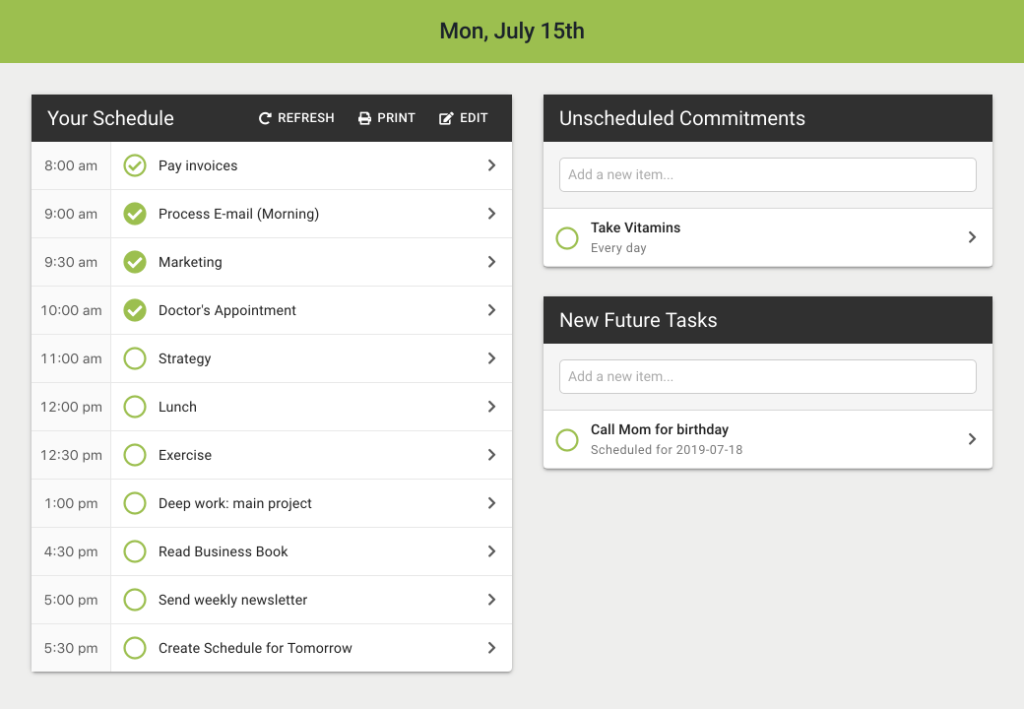In the demanding world of legal practice, effective time management is more than a buzzword—it’s a necessity.
From client communication to daily tasks, lawyers must juggle numerous responsibilities, requiring that their time management skills be top-notch.
This article provides crucial strategies tailored to the unique demands of the those working at law firms, aiming to elevate the daily practice of lawyers everywhere.
1. Plan Every Day
To manage daily tasks effectively, a lawyer must foresee the challenges of the day. Adjusting to ever-changing court dates, client meetings, and other priorities requires timely daily planning.
Take the time to sit down each day and plan out what you will do, how long you plan to spend on each activity and when you plan to do each.
While you may need to adjust your plan throughout the day, a daily planning process forces you to make deliberate trade-offs in your conflicting priorities, so you can get the most value out of each day.
Digital day planners like Day Optimizer or a classic desk diary can ensure your daily plan is always with you, so you can reference and adapt it throughout your day.
2. Time Box “Rabbit Hole” Tasks
Lawyers often fall into the trap of spending excessive time on tasks with no clear endpoint, like legal research, or tasks where perfectionism can be taken to an extreme, like drafting legal documents.
Knowing when you are hitting the point of no return, and what level of quality you are targeting are two key time management skills that can help with these tasks. But without an external driver, it’s still easy to go down a rabbit hole and spend more time than is needed.
Time boxing provides a solution by setting a defined block of time to tackle these activities. While similar to time blocking—where you set aside time to make progress on a task—with time boxing you are committing to finishing the task within this block of time.
This change in perspective, from making progress to finishing, alters how you approach the task and is particularly useful for tasks with no clear endpoint or where you suffer from perfectionism.
That’s not to say that you won’t ever need an extension of time if you time box. You sometimes will. But you’ll be working more effectively than if you don’t set a time limit upfront.
Overall, the time boxing technique prevents poor time management habits and helps lawyers stay aligned with their to-do lists.
3. Leverage Time Block Blueprints
For challenging tasks that you have allocated a significant amount of time to, or tasks that you do repeatedly, create a time block blueprint to guide you as you work on the task within that time block.
A time block blueprint is a roadmap for your time block—a way of time blocking your time blocks.
For instance, a basic time block blueprint for spending 30 minutes making a social media post might be:
| Write post | 10 minutes |
| Publish on 3 platforms | 5 minutes |
| Reply to comments | 5 minutes |
| Read feeds | 10 minutes |
This follows the goal of optimizing the time within that time block by first publishing content, then engaging with others, and finally consuming others content.
By putting the higher priority parts first, It ensures that if you spend more time than allocated on an earlier part, you can drop the other parts and still fit within the time you’ve allocated for that time block.
Time block blueprints should have:
- Checklist of Steps
To ensure you don’t miss anything. - Map of Time
To compare expectations against reality, so you can make adjustments during the time block. - Order of Importance
To nudge yourself to do the important things first. - Path to Improvement
To regularly review and revise your blueprints until you find a structure that works for you.
Regardless of how you approach them, before plunging into a chunk of uninterrupted time, create a mini-plan outlining how to approach your task within that time frame.
Whether it’s billable tasks like drafting documents or non-billable tasks like writing posts for marketing, a clear blueprint ensures a structured approach, minimizing time wasters.
4. Use the Prep-Do-Wrap Framework
When handling client meetings, court sessions, or any commitment, allocate adequate time before and after the actual time of the event. This “margin time” allows for reviewing case notes, ensuring timely travel, and taking post-event notes, a key aspect of time management for attorneys.
Use this framework to help you think about the time required for every task:
- Prep
Prepare for to do the work by getting to the correct location, setting up your environment or loading your mental state. - Do
Do the work itself. - Wrap
Reset to a neutral state by returning to your original location, restoring your environment, or unloading your mental state.
When we forget about the prep and wrap phases, we shortchange the amount of time allocated to the work itself, or leave ourselves and our environment in a state which isn’t conducive to the next thing we need to do.
Allocate Time for Each Phase
Each phase demands its share of attention. Here’s how you might approach them in your practice:
- Court Appearances
For the Prep phase, allocate enough time for getting dressed in the appropriate attire, traveling to the courthouse and mentally revisiting arguments. For the Wrap phase, allocate time after the hearing to take notes on the proceedings and travel time to return to your office. - Client Consultations
For the Prep phase, allocate time to review client files and set a meeting agenda, if you haven’t already. For the Wrap phase, allocate time to summarize discussed points, plan future interactions and send any emails or other necessary correspondence related to the meeting. - Legal Research and Document Drafting
For the Prep phase, allocate time to outline the scope of research or the structure of a document. For the Wrap phase, allocate time to review your findings, ensure documents are correctly saved or filed, and plan follow-up actions if necessary.
It’s essential to adapt the specifics of each phase according to the unique demands of your practice. The overarching objective is to ensure each phase gets its due attention, preventing inefficiencies or overlooked responsibilities.
Avoid Leaving Tasks Unfinished
By ensuring the Prep phase is thorough, attorneys can confidently handle the actual work, elevating their efficiency and reducing unnecessary stress. Conversely, neglecting the Wrap phase can be detrimental.
Unfinished tasks—be it a half-read legal document or a case file not returned to its place—create mental “open loops.” These nagging, unresolved items divert your mental resources, affecting your overall productivity.
Furthermore, the external environment plays a pivotal role. For instance, if your desk is cluttered with unrelated case files, it may hamper your ability to swiftly transition between tasks.
Though there might be situations where momentarily leaving a task undone can seem efficient, it’s generally wiser to adopt a completion-first approach. This ensures a clean slate and a fresh mindset for subsequent tasks.
5. Schedule Communication Blocks
Managing one’s communication effectively remains a pressing challenge for many in the legal field. Regularly, we find ourselves diverted by the continual influx of emails and phone calls, which can detract from our primary tasks and responsibilities.
While some interruptions cannot be avoided—when an important client calls you, you need to answer—one effective strategy is to allocate specific blocks of time in one’s daily schedule solely for attending to emails and outgoing phone calls.
By adopting this method, you can significantly minimize interruptions, allowing yourself to concentrate more effectively on your core tasks.
This structured approach to communication management not only enhances your productivity but ensures that client communications are addressed with the attention and thoroughness they require.
An added benefit of this disciplined approach is the potential improvement in client satisfaction. When communications are handled systematically and with due care, clients are more likely to feel valued and understood.
When implementing this strategy, it can be helpful to use regularly scheduled communication time blocks and to communicate these time blocks to your clients and colleagues. This sets up the expectation on the cadence of your responses.
6. Prioritize by Consequences
What would really happen if a particular task remains undone?
Prioritizing effectively requires discerning which tasks may be omitted without significant repercussions, and understanding the significance of the consequences for other tasks.
When pressed for time, don’t ask “What is the most important?” Instead ask “What will happen if I don’t do this (or don’t do it on time)?”
This reframe focuses on what might compromise client satisfaction or your long-term goals, ensuring a balanced schedule in your law firm.
We often overestimate the adverse outcomes of not completing certain tasks. As professionals, we naturally position our responsibilities at the forefront of significance.
However, many tasks may not be as pivotal as we perceive. When they genuinely are, delineating the potential consequences provides clearer insight into their true significance.
7. Remember Your Nourishment Habits
In the demanding world of legal practice, there’s an understandable emphasis on billable time. This metric often dictates a firm’s profitability and an attorney’s perceived value.
However, a broader perspective recognizes that while these billable hours are essential, they are not the sole determinant of your long-term success or efficacy. Your overall well-being and mental health cannot be overshadowed by the immediacy of client demands and the pressures of your practice.
Dedicate time to nourishing habits: eating right, regular physical activity, relaxation and reflection. These habits are not merely an act of self-care, but a strategic investment.
Take time to schedule these into your day to ensure that you don’t get so lost in your work that you forget to maintain the engine (your mind and body) that allows you to do that work.
By equipping yourself mentally and physically, you ensure that when faced with the demanding challenges of practicing law, you can approach those challenges with clarity, focus, and resilience.
And by prioritizing well-being, you not only safeguard your health but also amplify your capacity to deliver outstanding results for your clients, ensuring sustained success in your career.
Tips for Further Enhancement
Besides the strategies mentioned above, the following can also help you improve your time management as a lawyer:
- Leverage Digital Efficiency
Employ productivity tools like digital calendars to schedule daily tasks and active projects. - Address Unpleasant Tasks
Tackle the hardest task first. This approach clears your desk and mind, making subsequent tasks more manageable. - Stay Educated
Regularly educate yourself about time management issues specific to attorneys to continuously refine your strategies. - Audit Your Productivity
Keep track of your billable hours and compare them to your actual hours worked. Productivity breakdowns can then be addressed proactively. - Delegate When Necessary
Administrative tasks, though important, can often be delegated, freeing up blocks of time for more critical legal responsibilities. - Stay Balanced
Maintain a balance between billable tasks, client communication, challenging tasks, and self-care. A balanced lawyer is a productive one.
Incorporating these time management techniques will lead to enhanced individual productivity and a thriving legal practice. With disciplined application and regular reflection, lawyers can navigate the complexities of their profession while ensuring personal well-being.








